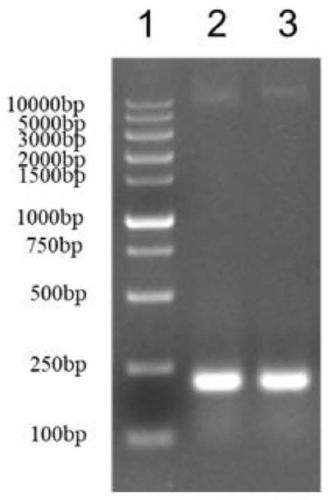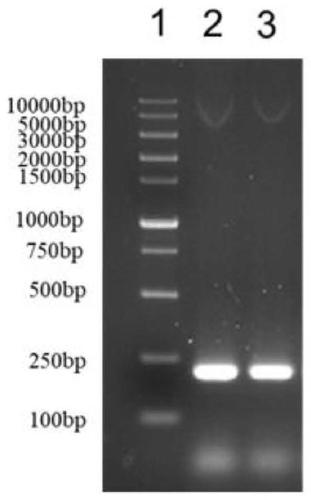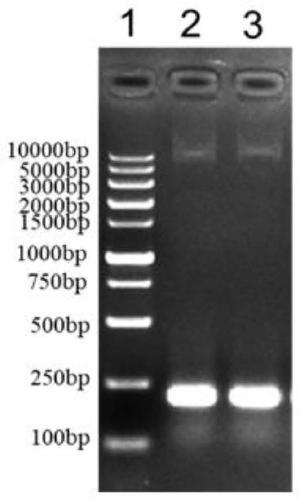Lactococcus lactis for expressing mouse antibacterial peptide gene
A technology of Lactococcus lactis and amino acids, which is applied in the field of genetic engineering, can solve the problems of decreased enzymes in the digestive tract and the inability to achieve intestinal targeted delivery, and achieve the effects of reducing intestinal inflammation, promoting the healthy development of the intestinal tract, and good industrial prospects
- Summary
- Abstract
- Description
- Claims
- Application Information
AI Technical Summary
Benefits of technology
Problems solved by technology
Method used
Image
Examples
Embodiment 1
[0060] Example 1 Construction of Recombinant Bacteria L.lactis NZ9000 / pMG36e-Usp45-CRAMP
[0061] 1. Construction of recombinant plasmid pMG36e-Usp45-CRAMP
[0062] (1) Codon preference optimization and synthesis of the gene sequence: According to the sequence of the target gene CRAMP gene and the characteristics of the expression vector pMG36e, and the signal peptide sequence Usp45 added for the purpose of efficient secretion and expression, artificially synthesized The 228bp codon-optimized sequence of the Usp45-CRAMP gene was sent to the company for synthesis. Xbal-Usp45-CRAMP-F is the upstream primer that contains the restriction site Xbal fused with pMG36e and the initial sequence of the 5' end of the signal peptide Usp45-CRAMP, and Usp45-CRAMP-Sph1-R is the signal peptide Usp45-CRAMP gene reverse primer. At the same time, primers pNZ1 and pNZ2 for PCR detection and sequencing of recombinant plasmids were also designed, which were designed based on the region of about 7...
Embodiment 2
[0067] Example 2 Construction of Recombinant Bacteria L.lactis NZ9000 / pNZ8148-Usp45-CRAMP
[0068] (1) Codon preference optimization and synthesis of the gene sequence: According to the sequence of the target gene CRAMP gene and the characteristics of the expression vector pNZ8148, as well as the signal peptide sequence Usp45 added for the purpose of efficient secretion and expression, artificially synthesized The 228bp codon-optimized sequence of the Usp45-CRAMP gene was sent to the company for synthesis. Sph1-Usp45-CRAMP-F is the upstream primer that contains the restriction site Xbal fused with pNZ8148 and the initial sequence of the 5' end of the signal peptide Usp45-CRAMP, and Usp45-CRAMP-Xbal-R is the signal peptide Usp45-CRAMP gene reverse primer. The optimized and synthesized Usp45-CRAMP sequence is shown in SEQ ID NO: 4; the optimized and synthesized Sph1-Usp45-CRAMP-F, Usp45-CRAMP-Xbal-R primer sequences are shown in SEQ ID NO: 7-8 respectively.
[0069] (2) PCR am...
Embodiment 3
[0073] Example 3 Induced expression of secretory recombinant Lactococcus lactis containing CRAMP gene in vitro
[0074] The recombinant bacteria L.lactis NZ9000 / pMG36e-Usp45-CRAMP recombinant expression bacteria constructed in Example 1 were respectively inoculated in GM17 liquid medium containing 5ug / mL erythromycin at a ratio of 1:100, and the recombinant bacteria constructed in Example 2 were Bacteria L.lactis NZ9000 / pNZ8148-Usp45-CRAMP was inoculated in GM17 liquid medium containing 5ug / mL chloramphenicol at a volume ratio of 1:100, and cultured overnight at 30°C; the overnight culture was inoculated at a ratio of 1:50 Inoculate in 10mL liquid medium containing corresponding antibiotics, and continue to cultivate for about 2.5h until the bacteria enter the logarithmic growth phase (OD 500 =0.4~0.6), add 40ng / mL nisin (nisin) to the L.lactis NZ9000 / pNZ8148-Usp45-CRAMP culture system to induce 4h, centrifuge at 10000rpm at 4°C for 5min, collect the culture supernatant, and a...
PUM
 Login to View More
Login to View More Abstract
Description
Claims
Application Information
 Login to View More
Login to View More - R&D
- Intellectual Property
- Life Sciences
- Materials
- Tech Scout
- Unparalleled Data Quality
- Higher Quality Content
- 60% Fewer Hallucinations
Browse by: Latest US Patents, China's latest patents, Technical Efficacy Thesaurus, Application Domain, Technology Topic, Popular Technical Reports.
© 2025 PatSnap. All rights reserved.Legal|Privacy policy|Modern Slavery Act Transparency Statement|Sitemap|About US| Contact US: help@patsnap.com



